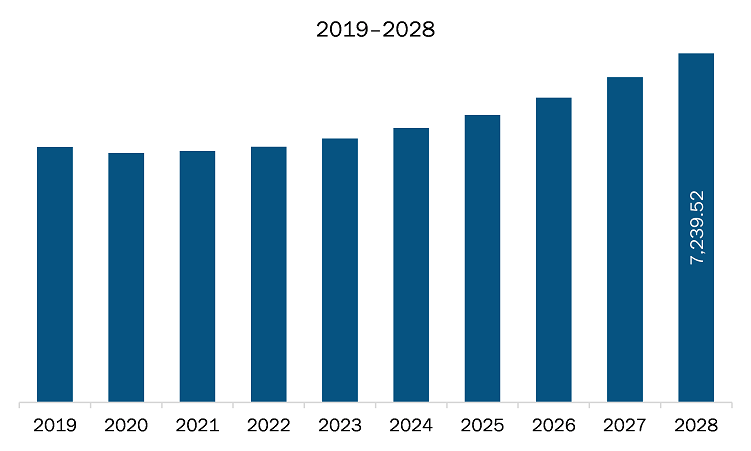The mechanical ventilation systems market in North America is expected to grow from US$ 5216.29 million in 2021 to US$ 7239.52 million by 2028; it is estimated to grow at a CAGR of 4.8% from 2021 to 2028.
Growth in smart cities and green building initiatives is driving the mechanical ventilation system market. Stringent government regulations to reduce energy consumption and increased demands for sustainable building options has led to the construction of green buildings. Growing emphasis on indoor environmental quality (IEQ) in green buildings is increasing the installations of mechanical ventilation systems. There is a growing demand for the use of energy recovery ventilation, whole-house fans, and energy-saving exhaust fans among the green building builders to address ventilation, moisture control, and local exhaust, supply air filtration, radon protection, and contaminant control. Countries such as the US and Canada are actively pursuing a smart city strategy. Ryerson University in Toronto, Canada, is studying the economic impact of mechanical ventilation in buildings, offsetting carbon emissions and making them carbon neutral. According to the US Green Building Council (USGBC), green buildings with supportive mechanical and energy ventilators can lead to a 10% increase in asset value. Such initiatives have increased the construction of more “green buildings” and have subsequently surged the demands for mechanical ventilation systems, which is significantly driving market growth.
The increasing number of infected individuals has led governments of North American countries to shut down nation’s borders during Q2 of 2021. Manufacturing facilities are either temporarily shut or are operating with limited staff strength; moreover, the supply chains of components and parts are disrupted. The United States is the largest markets for mechanical ventilation system, especially due to its technologically advanced aerospace & defense and manufacturing sectors. However, the outbreak has severely affected the production and revenue generation due to lowered production volumes. Thus, the COVID-19 pandemic continues to have a negative impact on the growth of the mechanical ventilation system market in North America.
With the new features and technologies, vendors can attract new customers and expand their footprints in emerging markets. This factor is likely to drive the North America mechanical ventilation systems market. The North America mechanical ventilation systems market is expected to grow at a good CAGR during the forecast period.

- This FREE sample will include data analysis, ranging from market trends to estimates and forecasts.
North America Mechanical Ventilation Systems Market Segmentation
North America Mechanical Ventilation Systems Market – By Type
- Exhaust Ventilation
- Supply Ventilation
- Balanced Ventilation
- Energy Recovery Ventilation
North America Mechanical Ventilation Systems Market – By Application
- Industrial
- Residential
- Commercial
North America Mechanical Ventilation Systems Market – By Country
- US
- Canada
- Mexico
North America Mechanical Ventilation Systems Market – Companies Mentioned
- Vortice
- BLAUBERG
- Infineon Technologies AG
- AERMEC
- Mitsubishi Electric Corporation
North America Mechanical Ventilation Systems Report Scope
| Report Attribute | Details |
|---|---|
| Market size in 2021 | US$ 5216.29 Million |
| Market Size by 2028 | US$ 7239.52 Million |
| CAGR (2021 - 2028) | 4.8% |
| Historical Data | 2019-2020 |
| Forecast period | 2022-2028 |
| Segments Covered |
By Type
|
| Regions and Countries Covered |
North America
|
| Market leaders and key company profiles |
|
- Historical Analysis (2 Years), Base Year, Forecast (7 Years) with CAGR
- PEST and SWOT Analysis
- Market Size Value / Volume - Regional, Country
- Industry and Competitive Landscape
- Excel Dataset
Recent Reports
Testimonials
Reason to Buy
- Informed Decision-Making
- Understanding Market Dynamics
- Competitive Analysis
- Identifying Emerging Markets
- Customer Insights
- Market Forecasts
- Risk Mitigation
- Boosting Operational Efficiency
- Strategic Planning
- Investment Justification
- Tracking Industry Innovations
- Aligning with Regulatory Trends





















 Get Free Sample For
Get Free Sample For